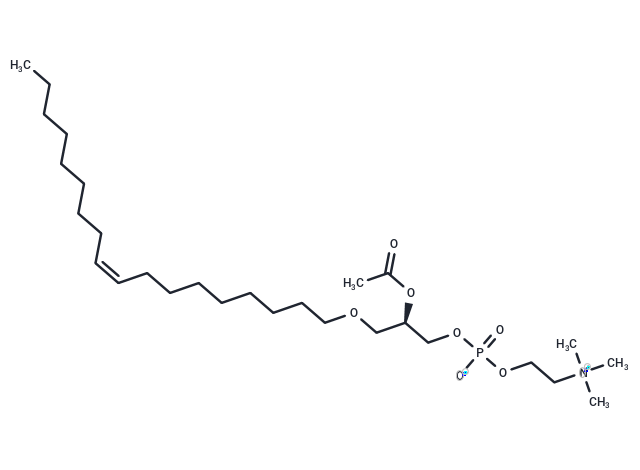Shopping Cart
- Remove All
 Your shopping cart is currently empty
Your shopping cart is currently empty

PAF C-18:1 is a naturally occurring phospholipid produced by cells upon stimulation and plays a role in the establishment and maintenance of the inflammatory response. It is less potent than PAF C-16 and PAF C-18 in the induction of neutrophil chemotaxis, but is equipotent to PAF C-16 and PAF C-18 in promoting eosinophil migration. PAF C-18:1 activates the PAF receptor and has been used in antibody binding experiments to determine the importance of an acyl linkage at the sn-2 position for recognition at this receptor.

| Pack Size | Price | Availability | Quantity |
|---|---|---|---|
| 5 mg | Inquiry | 35 days | |
| 10 mg | Inquiry | 35 days | |
| 25 mg | Inquiry | 35 days |
| Description | PAF C-18:1 is a naturally occurring phospholipid produced by cells upon stimulation and plays a role in the establishment and maintenance of the inflammatory response. It is less potent than PAF C-16 and PAF C-18 in the induction of neutrophil chemotaxis, but is equipotent to PAF C-16 and PAF C-18 in promoting eosinophil migration. PAF C-18:1 activates the PAF receptor and has been used in antibody binding experiments to determine the importance of an acyl linkage at the sn-2 position for recognition at this receptor. |
| Molecular Weight | 549.73 |
| Formula | C28H56NO7P |
| Cas No. | 85966-90-1 |
| Storage | Powder: -20°C for 3 years | In solvent: -80°C for 1 year | Shipping with blue ice. |
| Solubility Information | H2O: 20 mg/mL (36.38 mM), Sonication is recommended. DMF: 10 mg/mL (18.19 mM), Sonication is recommended. DMSO: 10 mg/mL (18.19 mM), Sonication is recommended. PBS (pH 7.2): 20 mg/mL (36.38 mM), Sonication is recommended. Ethanol: 10 mg/mL (18.19 mM), Sonication is recommended. |
Solution Preparation Table | |

Copyright © 2015-2025 TargetMol Chemicals Inc. All Rights Reserved.